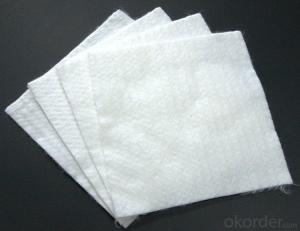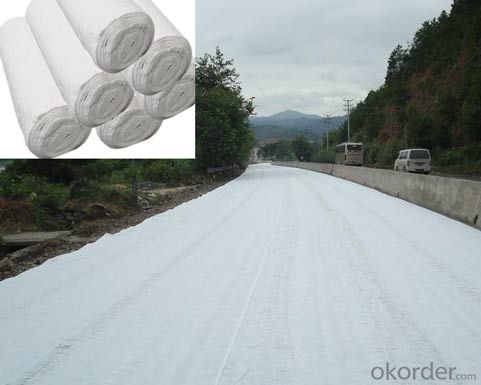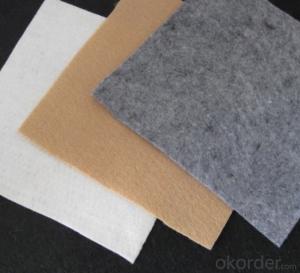Geotextile Ts 20 Non Woven Geotextile with Short Fiber from China
- Loading Port:
- China main port
- Payment Terms:
- TT OR LC
- Min Order Qty:
- 10000 m²
- Supply Capability:
- 5000000 m²/month
OKorder Service Pledge
OKorder Financial Service
You Might Also Like
Non Woven Geotextile with Short Fiber Needle Punched, Find Details about Non Woven Geotextile with Short Fiber Needle Punched and Make an Inquiry for Geotextile at OKorder.com.
Geotextile Specifications:
Geotextile fabrics
Material: PP/PET fibric
Width:1-9 m
Colour:white or black
Use:road ,highway,filter
Weight:100-1000g/m2
Tensile strength:2.5KN/m-25KN/m
Break elogation:25-100%
Gextextile Description:
--Our geotextile can be made of polypropylene (PP) or polyester (PET) .
--The weight is available from 100g/m2 to 1500g/m2 and the width from 1m to 9m,
-- Two kinds of processing technical to select: needle punched and thermally bonded, long fiber or short fiber.
-- All kinds of colors are available.
It is widely known as earthwork material and industry fabric, used in the areas of railway, highway, water conservancy, dam, tunnel, subway, environment protection and so on.
-- We can supply different specifications as customers’ request.
Geotextile Specification:
Material: polypropylene (PP) thermally bounded
Weight: 100g/m2-1500g/m2
Width: 1-9m
Length: As customers’ demand (usually is 100m)
Package: PE film and woven cloth
Delivery time: With in 3weeks after received the advance payment
PS. Also we can produce the product as customer’s demand.
Application of Geotextile:
1. Filtration
The filtration layer of the dykes, river canal, seacoast, concrete slope, retaining walls. At the same time of preventing the clay granule from passing, it allows the water and the gas pass through freely.
2. Separation
The isolation of the railway dregs and the roadbed, roadbed and the soft base, surface of the airdrome and parking lot and the groundsill, different dam materials. It isolates the soil and the gravel of two kinds different granule pathway from the groundsill or other buildings.
3. Reinforcement
The highway, railway, soilstone dam, breakwater, airport, backfill soil of retaining wall, slope protection, etc in which distributes the earth stress, prevents the side-displacement of the earth body and improves the earth body stability.
4. Protection
It prevents the bank from being washed out, protects the bank and the bottom, prevents the water and soil from being washed away.
Technical specification of short fiber needle punched non-woven geotextiles:
According to GB/T17638-1998 Standard
Geotextile Specification
 Geotextile Show:
Geotextile Show:






RFQ:
- Q: What can we do for the special customer?
A: Provide custom made service with customer's drawing; We make sure to provide you with the best solutions for your individual case. Whether standard items or non-standard items.
- Q: What can we supply?
A: We provide high levels of communication from start to finish.
- Q: What is our advantage?
A: Top Cemented Carbide has extensive business experience, Fast delivery and high quality.
If you want to find more details about the non-woven geotextile, you could make an Inquiry in okorder.com. Okorder.com provides you the products with best price and quality!
- Q: Roof garden drainage board and cover two layers of geotextile need to do what inspection lot
- I am specializing in the production of drainage board and geotextile and other materials, wish smooth
- Q: Can geotextiles be used in mining operations?
- Yes, geotextiles can be used in mining operations. They are commonly used for various purposes such as erosion control, soil stabilization, filtration, and drainage in mining sites. Geotextiles offer benefits like increased slope stability, reduced sediment runoff, improved water quality, and enhanced overall site performance in mining operations.
- Q: How do geotextiles help in reducing soil erosion caused by wind?
- Geotextiles help in reducing soil erosion caused by wind by acting as a physical barrier, preventing the soil particles from being lifted and carried away by the wind. The geotextiles are placed on the soil surface, effectively trapping the soil particles and allowing water to pass through. This helps to stabilize the soil, preventing erosion and promoting vegetation growth.
- Q: What is the difference between a hard pipe and a mesh plastic blind ditch?
- Different products, all play the role of drainage ditch need to wrap geotextered soft water pipe does not require geotextile package. Huazhi geotextile material answer
- Q: Detailing the geotextile standard which, how to apply their own
- GB GB I specialize in the production of geotechnical materials
- Q: How do geotextiles contribute to soil moisture retention?
- Geotextiles contribute to soil moisture retention by acting as a barrier that prevents water evaporation from the soil surface, while still allowing water to pass through and be absorbed by the soil. This helps to maintain a higher level of soil moisture, reducing water loss and promoting healthier plant growth. Additionally, geotextiles can also prevent soil erosion, which further aids in retaining soil moisture.
- Q: Can geotextiles be used in the protection of underground cables and pipes?
- Yes, geotextiles can be used in the protection of underground cables and pipes. Geotextiles act as a barrier, preventing soil particles and fines from infiltrating the cables or pipes, thus reducing the risk of damage or blockage. Additionally, they provide support and reinforcement to the surrounding soil, minimizing the potential for settlement or shifting that could affect the underground infrastructure.
- Q: How do geotextiles improve the performance of tunnels?
- Geotextiles improve the performance of tunnels by providing reinforcement and stabilization to the surrounding soil, preventing soil erosion and subsidence. They also act as a barrier to prevent the migration of fine particles, improving the overall durability and longevity of the tunnel structure.
- Q: Where to sell waterproof geotextile
- Hello, waterproof geotextile is a composite geomembrane if necessary to the Department of Huazhi geotextile material manufacturers to answer the beginning of 135, 4791 last 9192, do not forget Oh
- Q: Geotextile construction inspection batch ye do?
- Willing to smash the acceptance of smashing acceptance in vain
Send your message to us
Geotextile Ts 20 Non Woven Geotextile with Short Fiber from China
- Loading Port:
- China main port
- Payment Terms:
- TT OR LC
- Min Order Qty:
- 10000 m²
- Supply Capability:
- 5000000 m²/month
OKorder Service Pledge
OKorder Financial Service
Similar products
Hot products
Hot Searches
Related keywords

































